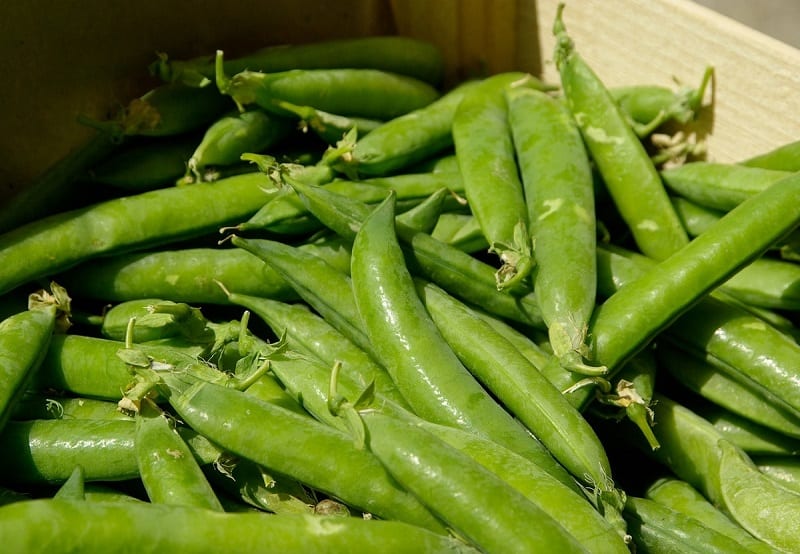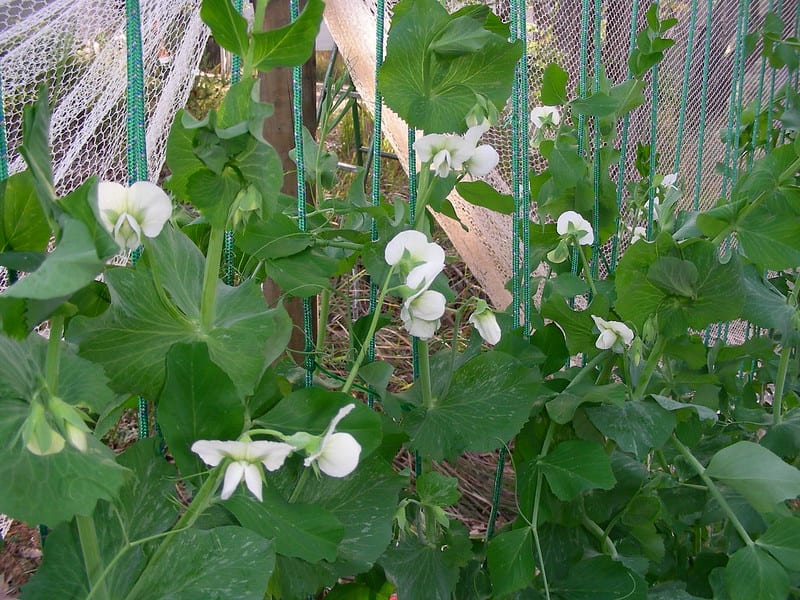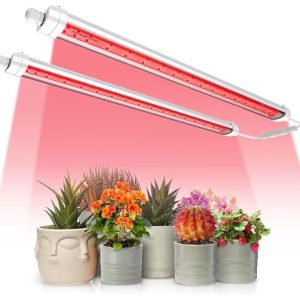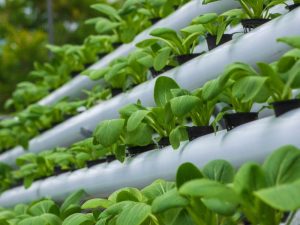Last Updated on June 24, 2024 by teamobn
Experienced gardeners will tell you that growing a crop of sugar snap peas is an excellent way to start your own edible garden. Home-grown sugar snaps are much sweeter, more succulent, and far tastier than anything you can grab from a grocery shelf.
You can choose from climbing or bush sugar snap peas varieties. Bush peas can grow to three feet tall. You’ll need to provide the plants with something to climb on or they’ll sprawl across the ground.
Climbing varieties can reach six to eight feet tall. These varieties require trellises. The pea tendrils will wrap around supports that are about ¼ inch in diameter. To help the plants climb, you will need to add twine, string, a wire mesh, or netting to the trellis.

Growing Sugar Snap Peas
Contents
Sugar snaps thrive in soil that is rich in organic nutrients. In some areas, you can plant pea seeds in the summer, about two months before the first fall frost.
In warm regions, plant the seeds in an area that gets full morning sun and partial shade during the hottest hours of the day.
If you live in a cool climate, plant the seeds directly into the garden after the last spring frost. Be sure to plant your crop in a well-draining spot that receives full sun for most of the day.
Here’s how to grow sugar snaps in your backyard.
Planting Sugar Snap Seeds
Growing sugar snap peas from seeds is a rewarding experience, yielding crisp, sweet peas that enhance your garden and your table. Planting them correctly is crucial to ensuring healthy, vigorous plants that will thrive and produce abundant harvests. Here’s a detailed guide on planting sugar snap peas to get your garden off to a great start.
Depth and Spacing for Optimal Growth
When planting sugar snap peas, place the seeds 1 to 1½ inches deep into the soil. This depth ensures the seeds are secure and can access the moisture they need to germinate. Space each seed about 2 inches apart. This allows enough room for the plants to grow without overcrowding. For bush varieties, you can plant rows 12 to 18 inches apart. This compact spacing works well for smaller gardens or raised beds.
Climbing varieties need more room, so space rows 18 to 24 inches apart. This distance provides ample space for trellises and supports without shading neighboring rows. Always check the seed package for specific spacing instructions tailored to your chosen variety.
Preparing the Soil for Sugar Snap Peas
Sugar snap peas prefer well-drained, fertile soil rich in organic matter. Before planting, improve your soil with compost or aged manure. This not only enriches the soil with essential nutrients but also enhances its structure and drainage capabilities.
If you’re planting in heavy clay or sandy soil, additional amendments like perlite or sand can improve texture and water retention. Aim for a neutral to slightly acidic pH level, around 6.0 to 7.5, which is ideal for pea growth.
Addressing Nutrient Deficiencies
Cold, nutrient-poor soil can hinder the growth of sugar snap peas. To combat this, apply a natural inoculant to the soil before planting. Inoculants are beneficial bacteria that help peas fix nitrogen from the air into the soil, a process essential for robust plant development.
These bacteria form symbiotic relationships with pea roots, enhancing nutrient absorption. This is particularly beneficial if your soil has low nitrogen levels or if your plants show slow growth initially. You can find inoculants at garden centers, often labeled specifically for legumes like peas and beans.
Adjusting Planting Practices for Climate
The timing and method of planting can vary based on your climate. In cooler regions, wait until after the last spring frost to plant your seeds directly in the garden. For warmer climates, consider planting sugar snap peas in late summer or early fall, about two months before the first expected frost. This allows the plants to grow in cooler weather, which they prefer.
In areas with hot summers, choose a spot that gets full morning sun but has some afternoon shade. This can protect the young plants from excessive heat, which can stress them and reduce yield.
Watering and Early Care
After planting, water the seeds gently to settle the soil around them. Maintain even moisture during the germination period, which typically takes 7 to 14 days. Once the seedlings emerge, reduce watering frequency but ensure the soil stays consistently moist. Overwatering can lead to root rot, especially in heavy soils, so it’s crucial to strike a balance.
As your sugar snap peas grow, thin out weaker seedlings to prevent overcrowding. This gives the remaining plants enough space to develop strong roots and stems, setting the stage for a productive growing season.
By following these guidelines for planting sugar snap peas, you’ll set the foundation for a healthy and productive crop. With the right care and conditions, you can enjoy the sweet, crunchy harvest of sugar snap peas straight from your garden.

Caring for the Plants
Caring for sugar snap peas is straightforward, making them an excellent choice for both novice and experienced gardeners. With minimal effort, you can ensure these peas thrive and yield a bountiful harvest. This section will guide you through essential care practices to keep your sugar snap peas healthy and productive.
Managing Pests
Several pests are particularly attracted to sugar snap peas, including pea moth caterpillars, slugs, and cucumber beetles. These pests can cause significant damage by feeding on the leaves, flowers, and pods of the plants. Regular inspection is essential to spot these invaders early.
For minor infestations, handpicking is an effective and environmentally friendly method. Check your plants frequently and remove any visible pests. For larger infestations, you can make a homemade pesticide. Mix water with a little vegetable oil and a few drops of mild liquid detergent in a spray bottle. This solution suffocates soft-bodied pests without harming the plants. Spray it directly on the pests and affected areas.
Supporting Plant Growth
While sugar snap peas are low maintenance, providing support for climbing varieties is crucial. As the vines grow, they need something to climb on. Use trellises, stakes, or a mesh netting system to keep the plants upright and off the ground. This support helps prevent diseases by improving air circulation and reducing the risk of rot from soil contact. It also makes harvesting easier by keeping the pods more accessible.
Feeding and Fertilizing
Although sugar snap peas can fix their own nitrogen, they still benefit from nutrient-rich soil. If your plants appear stunted or have yellowing leaves, a light feeding with a balanced fertilizer or compost tea can provide a boost. Apply the fertilizer at the base of the plants, taking care not to overfeed, as too much nitrogen can lead to lush foliage at the expense of pod production.
Mulching for Moisture Retention
Mulching around your sugar snap peas is another excellent practice. A layer of organic mulch, such as straw or shredded leaves, helps retain soil moisture, suppress weeds, and keep the soil temperature stable. This is especially beneficial in hot climates, where the soil can dry out quickly.
Regular Monitoring and Maintenance
Consistent monitoring and maintenance are key to a successful sugar snap pea crop. Check your plants regularly for signs of pests or disease, and address any issues promptly. Removing dead or yellowing leaves can prevent the spread of diseases and improve overall plant health.
With these simple care practices, your sugar snap peas will flourish, providing you with a plentiful harvest of sweet, crisp pods throughout the growing season.

(Photo: Doug Beckers/Flickr)
Harvesting Sugar Snap Peas
Your sugar snap peas crop will be ready for harvest six to eight weeks after sowing. Harvest them while the pods are green and still tender. Snap off the tough ends, pull off any strings, and eat the entire pods or just the peas inside.
Sugar snap peas grow fast. Check them often and harvest as frequently as necessary or the pods will become starchy and tough. They will eventually lose their sweet flavor. Harvesting often also encourages the plants to produce more pods.
Here’s a helpful tip. Sugar snaps are part of the legume family of vegetables, which store nitrogen in little nodules in their roots. Dig the roots directly into the soil when the plants finish cropping and they will slowly release the nitrogen for other plants to use.
Conclusion
Growing sugar snap peas from seed is a simple and rewarding endeavor for any gardener. With the right planting, care, and pest management, these peas will thrive and yield a plentiful harvest. Their sweet, fresh flavor straight from your garden makes all the effort worthwhile, enhancing your meals with a touch of home-grown goodness.








